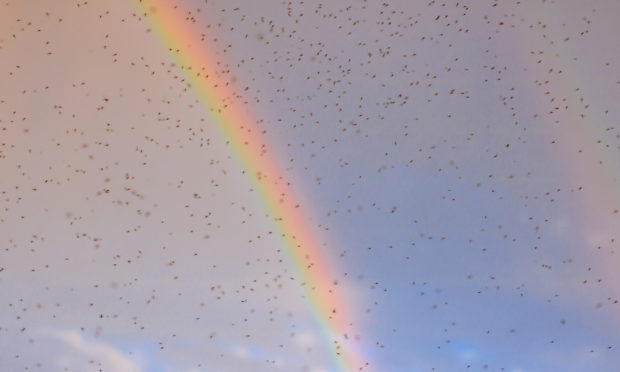Thanks to the Covid-19 crisis, lots more people than usual have been taking staycations this year, holidaying in the UK instead of the beaches of the Mediterranean or Florida.
That has resulted in more people – including, briefly, Boris Johnson – heading for the Highlands, often for the first time.
And many of them have discovered the reason more people don’t take Highland holidays as a matter of course – Culicoides impunctatus, better known as the Highland midge.
There may be deadly spiders in Australia, poisonous snakes in India, man-eating lions in Africa, but none of these can really compare to the midge. For most of us in Scotland, the menace is well known, and we know that nothing short of a full set of armour will totally deter their attacks. Indeed, just last week a BBC film crew was forced to abandon work in Lochaber after being assailed by swarms of them.
There are more than a thousand species of midges around the world, with 36 of these found in Scotland. However, only a handful of these are bloodsuckers, and the Highland midge is by far the worst.
Only the female of the species actually bites, requiring mammalian blood for reproduction. The first midges usually appear in May, though these are predominantly males, which don’t bite. However, the females aren’t far behind and from June until September will attack any warm-blooded mammal they encounter, attracted by the smell of their breath.
It’s worth pointing out that their most common victims are actually deer, cattle and sheep, with humans providing a handy back-up food supply.
Throughout history, there have been numerous records of people being driven mad by midges, from Bonnie Prince Charlie to Queen Victoria. They feature in Scottish literature too, with David Balfour being plagued by them in Appin in Robert Louis Stevenson’s Kidnapped.
However, I reckon the best description comes in Neil Munro’s Tales of Para Handy. As the crew of the Vital Spark are attacked by midges at Arrochar pier, the engineer Macphail tries to claim he’s experienced worse on the River Congo. However, Para Handy is having none of it.
“The Congo’s no’ to be compared wi’ the west o’ Scotland when ye come to insects,” he states. “There’s places here that’s chust deplorable whenever the weather’s the least bit warm. Look at Tighnabruaich – they’re that bad there, they’ll bite their way through corrugated iron roofs to get at ye! Take Clynder, again, or any other place in the Gareloch, and ye’ll see the old ones leadin’ roond the young ones, learnin’ them the proper grips. There iss a spachial kind of mudge in Dervaig, in the Isle of Mull, that hass aal the points o’ a Poltalloch terrier, even to the black nose and the cocked lugs, and sits up and barks at you.” Only a very slight exaggeration.
The good news is that the lifespan of a Highland midge is only about 30 days, although in the summer months their numbers are replenished as quickly as they die off.
They prefer boggy peatlands for breeding, which explains why the west Highlands are more affected than the east coast. Memorable midge evenings have seen me attacked on Skye, in the hills above Mallaig, in Glen Strathfarrar, and most recently in Ullapool.
However, you can expect to find them at times in most places north of the central belt of Scotland, and one of the worst swarms I have ever encountered was in the car park at the Linn of Dee, after a day walking in the Cairngorms.
This summer has been one of the worst I can remember for midges. Perhaps it’s something to do with the weather we’ve experienced. Midges like damp, overcast conditions, and don’t like wind or bright sunshine. That explains why they’re at their worst in the early morning or at dusk, when the light is lower.
However, during the day, if the cloud is low and there’s a bit of drizzle in the air, that suits them too. It’s also worth remembering that the itch from each midge bite doesn’t come from the insect, but from our own bodies’ defence systems. As the body reacts to a bite, it sends histamines to repair the wound. That’s actually what causes the redness, the tiny spot and the itch, and why my wife has been downing antihistamine tablets in rather alarming quantities this summer.
But in reality there is no defence to them. In recent years, sales of midge hats, midge hoods and even full body midge suits have boomed, as has the emergence on to the market of assorted “effective” repellents. I’ve tried them all. Trust me, none of them work. The good news is that the midge season is now nearing its end – for this year at any rate. By the end of this month, most of the beasties should have thankfully disappeared.
However, millions, if not billions, of their eggs are even now lying dormant, just waiting for their brief 30-day lives in the sun next year. Unless the scientists come up with an effective deterrent before then. If staycations are to remain a thing, let’s hope they do.
Campbell Gunn is a retired political editor who served as special adviser to two first ministers of Scotland.











